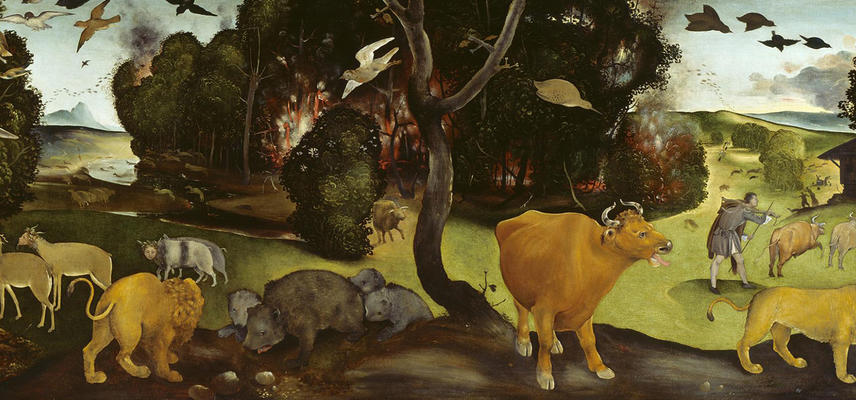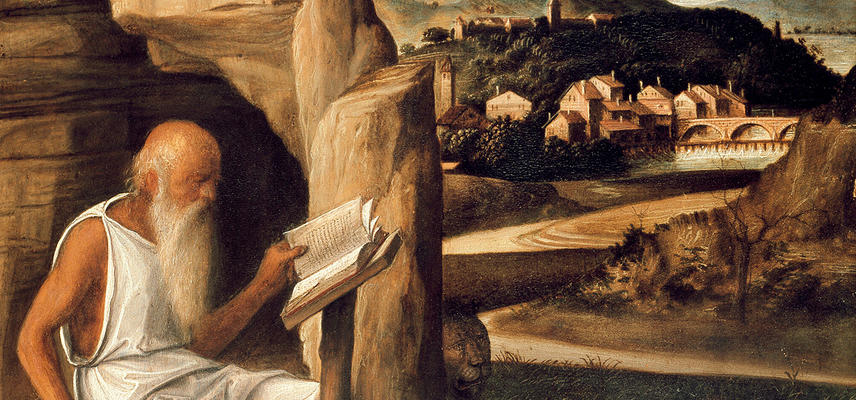ITALIAN RENAISSANCE GALLERY
Renaissance means rebirth and is the term used to describe the renewed interest in the art, architecture and literature of antiquity that took place in Europe from the 1400s to the late 1500s.
This gallery concentrates on the work of artists in Italy where Florence, Venice and Rome were key centres of artistic production and innovation.
The Hunt in the Forest by Paolo Uccello (1397–1475) is one of the best-loved and well-known paintings in the Museum’s collection and takes pride of place in this gallery. This magical work depicts a hunting scene taking place at night and is crammed with figures of huntsmen – some on horseback, others on foot – accompanied by eager hunting dogs. The composition shows Uccello’s fascination with perspective and geometry as everything converges on a central vanishing point.
The central cases contain some fine examples of Renaissance bronzes, carvings and ivory work. In an individual case stands a bust of Michelangelo Buonarroti (1475–1564) one of the key figures of the Italian Renaissance. The Ashmolean holds a world-famous collection of his drawings which can be seen by appointment. This bust was modelled by his friend, Daniele da Volterra, and clearly shows the broken nose which was the result of a brawl between Michelangelo and one of his pupils.
The Portrait of a Young Man by Alessandro Allori, hanging at one end of the gallery, shows how the wealthy would surround themselves with exquisite objects inspired by classical art.
Recent additions to the gallery include two newly-reframed Renaissance masterpieces: Saint Jerome Reading in a Landscape by Giovanni Bellini (1430–1516) and Portrait of a Young Man by Domenico Ghirlandaio (1449–1494). These reframes form part of a wider restoration project generously supported by Fondation Etrillard, which you can read about below.
The Hunt in the Forest (detail)
Portrait of a Young Man (detail)
The Forest Fire
The Triumph of Love
Saint Jerome reading in a Landscape (detail)
Rediscovering Bellini and Restoring Ghirlandaio's Vision
Thanks to a generous gift from Fondation Etrillard, we have been able to reframe three Renaissance paintings in our collection to more faithfully reflect their original historical contexts.
The Venetian master Giovanni Bellini is celebrated for his ability to convey serene spirituality through luminous colour. A wonderful example of this is Saint Jerome Reading in a Landscape, which for many years was enclosed in a large, ornate frame that overpowered the painting itself. It has now been reframed in a subtly gilded design by Peter Schade, based on 15th- and early 16th-century Italian models.
You can also see another Bellini masterpiece, The Virgin and Child, with its new frame in the adjoining Early Italian Art Gallery.
Also thanks to Fondation Etrillard’s support, our conservation team has removed the imitation Venetian frame from Domenico Ghirlandaio’s Portrait of a Young Man, revealing its original engaged frame that was carved as part of the panel itself. This painting now holds the rare distinction of being one of the very few 15th-century Italian portraits in the world to be displayed in its original integral frame.
This restoration project highlights the vital role of framing in how Renaissance paintings were originally intended to be seen, and how we understand and appreciate them today.










